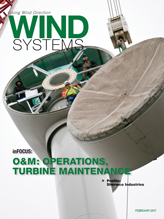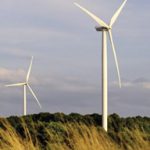The Energy Department released a report that confirms that adding even limited electricity transmission can significantly reduce the costs of expanding wind energy to supply 35 percent of U.S. electricity by 2050.
The report, Reducing Wind Curtailment through Transmission Expansion in a Wind Vision Future authored by the National Renewable Energy Laboratory (NREL), affirms the findings of the Energy Department’s 2015 Wind Vision, which showed that a future in which wind provides 20 percent of U.S. electricity in 2030 and 35 percent in 2050 is achievable and would provide significant economic, energy security, and health benefits to the nation.
Modeling Tool
For the study, NREL simulated operation of the electric power grid under a scenario where 35 percent of electricity comes from wind in the year 2050 using PLEXOS, an integrated modeling tool commonly used by utilities and transmission organizations.
The study focuses on the Western Interconnection grid, which includes 11 states, two Canadian provinces, and parts of northern Mexico where the U.S. grid crosses the border.
The study includes a baseline scenario assuming no significant transmission expansion across the western grid, as well as three scenarios with varying levels of transmission build out.
In the baseline scenario with no transmission expansion, substantial renewable energy curtailment — times in which wind farm operators are told not to produce energy due to limited capacity on the grid — could become a major issue.
In this scenario, about 15.5 percent of wind-energy capacity goes unused with consequent increases in system costs as a result of idled wind generation.
The study also finds that if just four currently proposed transmission projects are built, wind curtailment can be reduced by about half, cutting lost generating potential to 7.8 percent.
If the nation deploys additional transmission beyond those four proposed projects, wind curtailment can be reduced even further — allowing full use of wind energy, reducing generation costs, and unleashing additional economic and societal benefits.
Looking at Texas
This report quantifies on a regional scale what’s been seen in Texas in recent years: Wind curtailment on Texas’s grid ranged from 8 percent to 17 percent between 2009 and 2011, but fell to only 1 percent after new transmission lines and other upgrades were completed under Texas’s Competitive Renewable Energy Zone initiative.
Wind power is one of the fastest growing sources of new electricity generation in the United States and already is providing substantial economic, energy security, and health benefits.
This study affirms that even limited additions to transmission capacity would allow more wind energy from the Mountain States to power load centers on the West Coast. On the other hand, a lack of new transmission capacity could limit the growth of wind energy and its potential benefits.
Overall, the results of the study underline that utility grids can reliably operate with more than 35 percent wind energy and 12 percent solar energy, and they emphasize even limited transmission expansion can significantly ease the path to a renewable energy future.
Source: Energy Department’s Office of Energy Efficiency and Renewable Energy
For more information, go to energy.gov

































